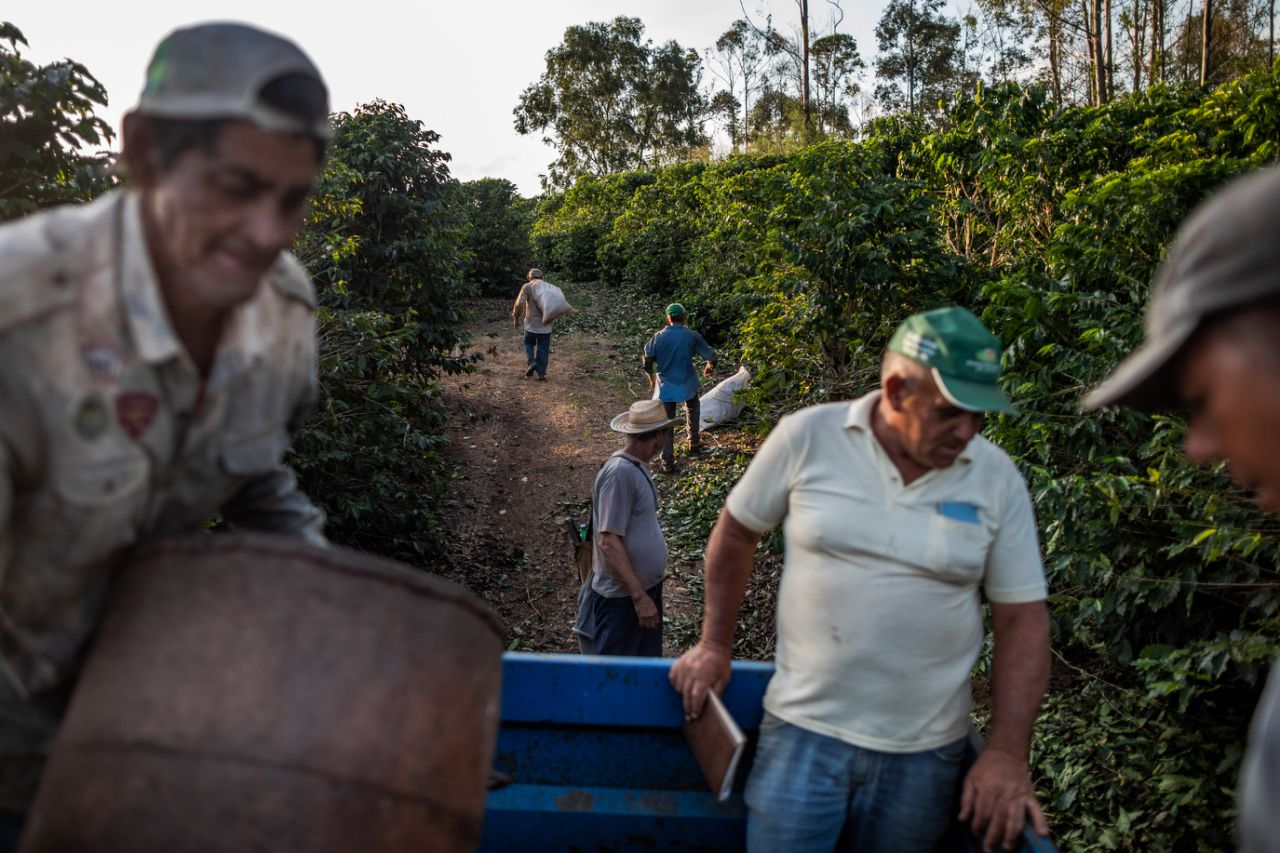Coffee is getting cheaper, but Brazil has found a way to increase production quickly at a low cost.
Professional coffee knowledge exchange more coffee bean information please follow the coffee workshop (Wechat official account cafe_style)
Rodrigo de Freitas Silva's coffee farm in central Brazil is booming, even after the worst price crisis in decades.
Over the past decade, the 41-year-old has doubled his acreage from 12.5 hectares to 220 hectares (544 acres). His entire farm is mechanized and 90% of the coffee trees are irrigated. Most importantly, although global coffee prices are near their lowest level in 13 years, Silva is profitable and expects to increase production on more land.

"I still have room to triple my coffee acreage, building on my existing farm," Silva said, showing an example of a lab that will sort coffee at his farm in Jeriquara, Sao Paulo.
The coffee boom in Brazil poses great challenges for coffee growers around the world. From Nicaragua to Tanzania, many growers produce fewer coffee beans per hectare, higher fertilizer and labour costs, and the exchange rate of export currencies is not as good as that of the Brazilian currency (real). The devaluation of the real has enabled Brazilian exporters to ship raw coffee beans overseas in exchange for more foreign exchange, which has greatly stimulated the planting motivation of producers.
Many non-Brazilian coffee farmers are forced to accept the benchmark price of ICE futures in New York, but these prices are lower than their production costs. Long-term losses and limited credit opportunities have prompted some growers (in Central America and Africa) to leave the industry.
Last week, from Mogiana in Sao Paulo to the south and Serrado in Minas Gerais, there were no signs of tension on coffee farms within more than 1700 kilometers (1056 miles). These areas account for 70% of Brazil's Arabica coffee bean acreage, which is the first choice for roasters such as Starbucks.
Everywhere, from the road to the top of the mountain, mature woods or a sea of green trees, there is scenery everywhere. The farmers who walked among them could not hide their pride in the bumper harvest.
"I have been expanding into new areas and renovating old areas to double their output," Silva said. "because the price of coffee is low, he has no plan to stop investing." I still make money from coffee.
Silva predicts that 10,000 bags of Arabica beans will be harvested by 2020, almost three times as much as this year and the lower year of the two-year cycle. He reinvested profits to expand, mechanize, irrigate and fertilize his farm. In 2016, his yield peaked at 136 bags per hectare in some parts of the farm, with an average yield of about 50 bags. A bag is 60 kilograms (132 pounds).
During a crop trip to the coffee belt in Brazil last week, healthy, well-treated trees were mainly found. On the roads of S ã o Paulo or Minas Gerais, new planting has emerged, surrounded by harvesters and even huge irrigation pools.
Brazilian farmers use profits from periods of higher prices to mechanize, replace low-yield trees and improve animal husbandry. This increases production and reduces costs for many people.
This high-speed development trend seems to have no brakes, heralding more bumper harvests.
Marcos Figueiredo, a farmer and warehouse operator in Araguari, Minas Gerais, said that barring serious weather problems, the South American country could reap a record harvest of up to 70 million bags by 2020.
"these coffee crops have never been handled so well," Figuereido said. "
Rodrigo Costa, US-based director of Brazilian exporter Comexim, said in a telephone interview that this ample supply explained why futures could not be maintained at high levels. Costa said that in addition to Brazil, Vietnam and Colombia have also invested in increasing production and global supply in recent years.
Coffee futures in New York tumbled on Wednesday, the biggest drop since 2015, surging 19 per cent in the past two weeks as wet weather or frost could affect Brazilian crops. The most active futures trading prices are close to their lowest level since 2005.
That doesn't seem to stop Nero Teixeira Diaz (Nairo Teixeira Dias), a 66-year-old coffee grower in Machado, Minas Gerais. Most of Diaz's farms are in the mountains, where harvesting cannot be mechanized, and the cost of harvesting is almost three times that of mechanized farms. Even so, Diaz suffered no losses on his 150-hectare coffee farm.
"of course, other crops will have higher profit margins, but coffee is still better than other crops," he said.
The farmers interviewed during the visit do not intend to reduce the use of chemical fertilizers or technologies.
In the savannas of Minas Gerais, Noel Francisco Bartolomeu Rodriguez (Noe Francisco Bartolomu Rodrigues), 37, as one of the owners of Farroupilha, a diversified planting group with 21 crops, is promoting crop renewal and expansion to reduce costs, improve quality and yield, and fully mechanize and irrigate 2070 hectares of coffee crops.
Farroupilha's harvest is expected to soar in 2020, in part because production will start in newly planted areas. The group also plans to add another 700 hectares of land over the next four years.
"the old non-irrigated areas with a productivity of 25 bags per hectare will be replaced by new areas where yields double," Rodriguez said.
Givago Miranda (Givago Miranda), the grower of Tres Pontas, does not plan to make any production cuts.
"by 2020, I will once again replace the old areas with new areas to maintain high yields," he said in an interview. Miranda, who grows 340 hectares of land, says the pace of renewal will depend on coffee prices. " We are looking for ways to achieve higher production costs and higher profits. "
Source: Bloomberg
END
Important Notice :
前街咖啡 FrontStreet Coffee has moved to new addredd:
FrontStreet Coffee Address: 315,Donghua East Road,GuangZhou
Tel:020 38364473
- Prev

Introduction to the characteristics and flavor of Panamanian coffee with low yield in the planting environment
Professional coffee knowledge exchange more coffee bean information Please pay attention to the coffee workshop (Wechat official account cafe_style) the geographical environment of Panama means that the domestic coffee producing areas have many unique microclimate, including many highly capable and dedicated coffee producers, so there are a lot of excellent quality coffee, of course, relatively expensive. The high price of coffee, on the one hand,
- Next

Introduction to the flavor and taste characteristics of Arabica coffee bean producing area ranked among the top ten coffee producing countries in the world
Professional coffee knowledge exchange more coffee bean information Please follow Coffee Workshop (Wechat official account cafe_style) Coffee, which has the title of black gold, is currently the world's largest traded commodity after oil, with an output value of US $50 billion, equivalent to NT $1.5 trillion. How to create a small coffee bean
Related
- Does Rose Summer choose Blue, Green or Red? Detailed explanation of Rose Summer Coffee plots and Classification in Panamanian Jade Manor
- What is the difference between the origin, producing area, processing plant, cooperative and manor of coffee beans?
- How fine does the espresso powder fit? how to grind the espresso?
- Sca coffee roasting degree color card coffee roasting degree 8 roasting color values what do you mean?
- The practice of lattes: how to make lattes at home
- Introduction to Indonesian Fine Coffee beans-- Java Coffee producing area of Indonesian Arabica Coffee
- How much will the flavor of light and medium roasted rose summer be expressed? What baking level is rose summer suitable for?
- Introduction to the characteristics of washing, sun-drying or wet-planing coffee commonly used in Mantenin, Indonesia
- Price characteristics of Arabica Coffee Bean Starbucks introduction to Manning Coffee Bean Taste producing area Variety Manor
- What is the authentic Yega flavor? What are the flavor characteristics of the really excellent Yejasuffi coffee beans?

